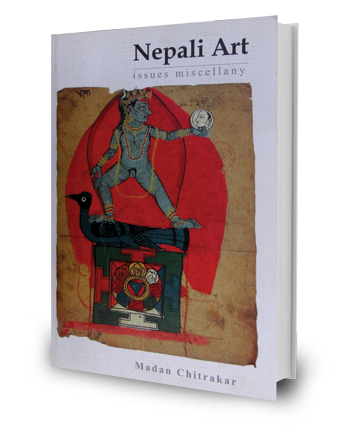A look into artist Madan Chitrakar’s book.
 Nepali Art- Issues Miscellany is a compilation of articles written by eminent artist Madan Chitrakar for various publications since 1976. It covers narratives, reflections and fascinations of the artist on assorted topics concerning art in Nepal, and is a seminal contribution to literature about Nepali art. Born to the influential artist Tej Bahadur Chitrakar, Madan Chitrakar has been immersed in art since his birth; and growing up in a legendary family of artisans, the Chitrakars, there are few better candidates to narrate the journey of Nepali art than him. It is a task the author has undertaken splendidly.
Nepali Art- Issues Miscellany is a compilation of articles written by eminent artist Madan Chitrakar for various publications since 1976. It covers narratives, reflections and fascinations of the artist on assorted topics concerning art in Nepal, and is a seminal contribution to literature about Nepali art. Born to the influential artist Tej Bahadur Chitrakar, Madan Chitrakar has been immersed in art since his birth; and growing up in a legendary family of artisans, the Chitrakars, there are few better candidates to narrate the journey of Nepali art than him. It is a task the author has undertaken splendidly.
The book begins with an exploration of religious forms and iconography, as the history of any region and its religions is best narrated by its art and sculptures. The book’s retelling of the history of Nepali art entwines with the artist’s own fascination with Paubha art. The origin of Paubha is explored deeply and the reader gets a perspective into the differences between Paubha and Thanka art. Paubha paintings are an art to admire; once mastered only by the Newari artisan clan- the Chitrakars. Of recent times it has become popular among other artists as well and the modern expressions of this traditional art is charted in great detail by the book. The author’s fascination with the ‘makara’ or the mythological character – a creature with the head of a crocodile and bird-like feet, often seen as spouts of dhunge dharas or public water spouts also features as an entire chapter.
The different twists and turns taken by Nepali art on its road to modernism are also documented briefly, so as to interest anyone, even those from a non-artistic background. For those from the art genre, the chapter is an invitation for further research.
The question of when western forms crept into Nepali art is another question that the author delves into. Many scholars place Bhaju Man Chitrakar’s journey to England with the then PM Junga Bahadur Rana as the beginning of western influence on Nepali art. The author starts his recanting here and traces it to the modern day. The last few chapters narrate to readers the works of eminent contemporary artists, making this book a must read – a complete store house for anyone who wants to know the relation of religion and art, and also the development of Nepali art from its origins to the modern day.
Teba-Chi Studies Centre, which is an initiative run by the author in memory of his father, is the publisher of the book. The book was launched in May 2012.










